The Venezuelan economy has drastically deteriorated in the last decade, driving an emigration exodus unprecedented in Latin American history. As of 2021, 7 million Venezuelans had left the country. Colombia has been one of the primary destinations, hosting around 2.5 million Venezuelan immigrants at the beginning of 2022 (National Planning Department 2022). Recent literature studying the impact of Venezuelan immigration in Colombia has found negative effects on wages for natives (Delgado-Prieto 2020; Caruso, Canon, and Mueller 2019) and positive effects on hours worked for natives and immigrants (Martínez Moya 2020). Other studies evidence negligible wage reduction in informal sector wages and a well-being loss close to zero for Colombian workers (Santamaria 2022).
However, most of these studies do not consider the COVID-19 period or how the impact of immigration has changed over time. These are interesting elements to consider, as they allow us to investigate whether the impact of immigration is permanent and to what extent the labor market is adapting to the immigration shock. Existing literature documents that immigrants are more vulnerable to negative shocks such as natural disasters, business cycles (Peguero 2006; Morando 2021), and COVID-19 (Béland, Brodeur, and Wright 2023), and that such negative shocks cause disproportionate labor market effects between immigrants and natives. For instance, the International Organization of Migration (IOM) documents that immigrants worldwide have been more vulnerable to economic shocks due to personal, social, and structural factors (IOM 2020).
In this paper, we assess the impact of emigration from Venezuela to Colombia on labor market outcomes in Colombia between 2016 and 2021. We analyze how the effect of immigration varies over time, which allows us to understand how the pandemic shapes the impact of immigration on labor market outcomes. Colombia is an interesting case study because of the magnitude of the immigration influx, persistent unemployment, and high informality. In particular, the unemployment rate is double the average among the Organization for Economic Cooperation and Development (OECD) countries, and the informality rate is one of the highest in the region (48.7 percent; OECD 2022).
We use two data sources for our analysis: Colombian household surveys and the national census. We estimate an event study and use an instrumental variables identification strategy to address endogeneity issues. This strategy exploits the variation of past settlements of Venezuelans across departments (states) and the distance between Venezuelan borders and Colombian departments. Following the official definition by the Colombian National Statistics Office (abbreviated DANE in Spanish), we define an immigrant as an individual who moved from Venezuela to Colombia; individuals are further classified as either recent or earlier immigrants.1Recent immigrants immigrated to Colombia less than 12 months before the survey year, and earlier immigrants did it between one and five years before the survey year. The differential analysis of these groups lies in the fact that the profile of immigrants changes over time. Moreover, this distinction allows for analyzing how the labor market adapts to the immigration influx, which is crucial in determining the urgent demands of immigrants and understanding the impacts on growth and productivity in the medium term.
Our specification enables us to estimate how the impact of immigration varies due to the COVID-19 pandemic. It allows for identifying whether a high incidence of immigration from Venezuela relates to a disproportional impact of the pandemic. In particular, total migration reduced the employment rate, labor participation, and hourly wages of natives. In the same way, total migration increased the hourly wages and informality. Conversely, the arrival of recent migrants decreased labor participation and hourly wages, and increased informality.
We also find that during the lockdown period, natives experienced a better recovery scenario than earlier migrants. For instance, in 2021, natives had a decrease in their informality rates, but earlier migrants increased their informality rates, though to a lesser degree than in 2020. In addition, we explore the heterogeneous effects of total migration and find that the native workers most affected by labor market outcomes are those who are young, female, low-educated, informal, or a combination thereof. The rest of the paper is organized as follows. Section 2 briefly presents related literature, while section 3 provides general context on emigration from Venezuela to Colombia. Section 4 describes the data and presents the empirical strategy. We present results in section 5. Finally, concluding remarks are presented in section 6.
2 Related Literature
This paper contributes to two threads of literature. First, it adds to the ample evidence about the labor market impact of migration in developing economies, specifically on South-North migration studies. Card (1990) was one of the pioneer authors who studied the impact of migration by using an instrumental variable approach to solve the endogeneity associated with the decision to migrate. He finds that Cuban immigration in the United States affects neither wages nor unemployment rates of low-skilled native workers. Years later, Borjas and Monras (2017) revisited Card (1990)’s results and found that Cuban immigration reduced wages for the low-skill native workers (whose substitutes workers are the immigrants) but had a favorable effect on high-skilled workers (see also Ottaviano and Peri 2012). Ruiz and Vargas-Silva (2013) and Verme and Schuettler (2021) provide literature reviews of the impact of forced migration on labor market outcomes.
More recent research for developing countries shows contrasting results. Ben Atta, Chort, and Senne (2022) find that migrants and asylum seekers increase the size of the informal sector in OECD host countries. Meanwhile, Ceritoglu et al. (2017), Tumen (2016), and Aksu, Erzan, and Kırdar (2022) show that Syrian migration affects the informal sector in Turkey, especially among more vulnerable groups, such as women, youth, and less-educated workers.
Venezuelan migration motivated similar studies for Latin American countries. For instance, Olivieri et al. (2022) for Ecuador and Boruchowicz, Martinelli, and Parker (2021) and Vera and Jiménez (2022) for Perú report negligible effects on hours worked, employment status, and wages, respectively. Shamsuddin et al. (2021) and Ryu and Paudel (2022) study the Venezuelan migrant inflow on the labor market outcomes in Roraima (a Brazilian city that borders Venezuela). Both papers show that Venezuelan migration decreased employment, mainly among women. Ryu and Paudel (2022) indicated specifically that women lost jobs in informal and self-employed sectors. By contrast, Gunadi (2021) finds no significant effect of Venezuelan migration on labor force participation, unemployment rate, or weekly wages in the United States.
The case of Colombia has also been considered, and heterogeneous impacts across formality status, skills, and gender have been reported. For instance, Caruso, Canon, and Mueller (2019) studied the consequences of Venezuelan immigration on labor and poverty outcomes for Colombians between 2013 and 2017.2Caruso, Canon, and Mueller (2019) consider immigrants who moved from Venezuela to Colombia in the preceding 12 months, which is the same definition we use to determine recent immigration and is consistent with the definition of DANE (2019). The authors document negative impacts on income and poverty using a shift-share instrument variable. Likewise, Delgado-Prieto (2020) finds a negative effect on wages and employment. The author argues that firms reallocate employment from formal to informal workers as a response to the reduction in informal wages, which is consistent with the findings in Santamaria (2022) that demonstrate that the reduction in employment in the formal sector is mostly explained by a transition of Colombians from the formal to the informal sector.
Bonilla-Mejía et al. (2020) show that Venezuelan immigration had no significant effect on natives’ unemployment but increased unemployment among immigrants. This is because job losses for natives are mostly driven by self-employed workers (see also Muñoz-Mora et al. 2022). Conversely, Lebow (2023) provides evidence of a null effect on employment but a negative and significant effect on the hourly wages of natives. Focusing on heterogeneous effects by gender, Pedrazzi and Peñaloza-Pacheco (2023) find that Venezuelan migration reduced employment for low-skilled female natives but increased employment for the high-skilled, especially those with children. Further work like Martínez Moya (2020), Lombardo et al. (2021), and Lombardo and Peñaloza Pacheco (2021) study the Venezuelan immigration effect on other outcomes, such as productivity, income distribution, and exports. The second thread of literature relates to the growing studies that investigate the COVID-19 impact on immigrants. For instance, ILO (2020) demonstrates that migrants in Jordan and Lebanon are more vulnerable to COVID-19 because they work mainly in the sectors most affected (characterized by high informality) and therefore experience more lay-offs and income drops. Morando (2021) reports similar results and argues that it is due to the occupation segregation of immigrants. In turn, Béland, Brodeur, and Wright (2023) find that immigrants in United States were disproportionally affected by COVID-19 compared to natives in terms of employment rate, hours worked, and wages (for further discussion, see Dustmann, Glitz, and Vogel 2010; Orrenius and Zavodny 2010; Sinha, Narain, and Bhanjdeo 2022; Atkeson 2020; Jordá, Singh, and Taylor 2020; Ramelliand Wagner 2020).
3 Context
3.1 Immigration from Venezuela to Colombia
In the last two decades, the Venezuelan government raised expenditures based on oil revenues. However, in 2014, the oil price went down, and consequently the Venezuelan economy contracted dramatically (OECD 2018; Lombardo et al. 2021; Alhadeff 2021). This shock produced a rapid increase in the inflation rate, a shortage in basic needs, and reduced GDP growth (Caruso, Canon, and Mueller 2019; Ramoni Perazzi et al. 2017).3The Venezuelan inflation rate was 929.8 percent in 2019 (Shamsuddin et al. 2021). This was coupled with political issues between the Colombian and Venezuelan governments. In 2015, the president of Venezuela, Nicolas Maduro, closed the border between Colombia and Venezuela, causing significant economic losses. Still, in July 2016, it was re-opened due to protests and international pressure.
As a result of a worsening socioeconomic and political situation, emigration from Venezuela increased substantially until it became the largest exodus in Latin American history and the second-largest worldwide after the Syrians. Between 2015 and 2019, around 5 million Venezuelans migrated to neighboring countries such as Colombia, Peru, Ecuador, Chile, Brazil, and Argentina (Wolfe 2021). The two main destinations for Venezuelan immigrants outside Latin America in 2018 were Spain and the United States (IADB and OECD 2021). Figure 1 shows that the number of Venezuelan immigrants in Colombia remained relatively stable until 2015 when the number reached 180,000 immigrants. Since then, there has been a remarkable upward trend, and as of 2020, Colombia hosts approximately 1.8 million Venezuelan immigrants.
Figure 1: Stock of Venezuelan immigrants in Colombia
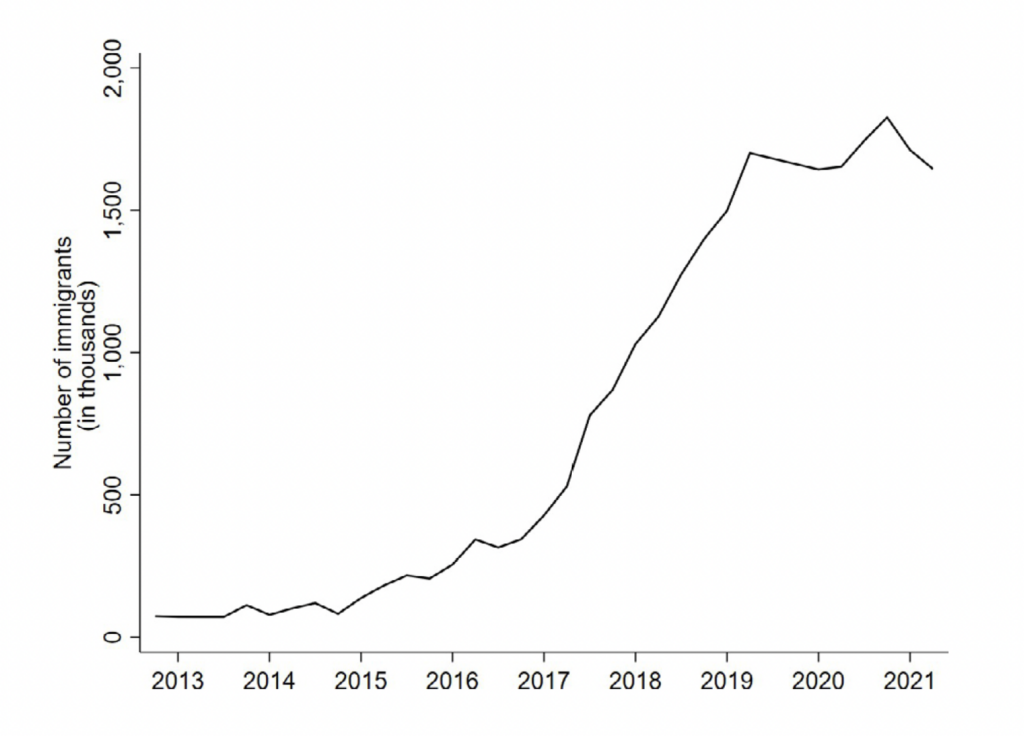
Notes: The sample is restricted to working-age immigrants. We apply interpolation techniques for the first and second quarters of 2020 to address the missing data issues that affected household survey collection during the COVID-19 pandemic confinement.
Two crucial moments in this timeline are 2017 and 2020. In 2017, the economic situation and the political violence (as a response to the protests due to the defeat of the opposition party in the local government elections) triggered a growing and rapid Venezuelan emigration. This growth trend stopped in 2020 when the stock of Venezuelan immigrants in Colombia declined slightly. Indeed, more than 80,000 Venezuelans returned to their country between the middle of March and the beginning of August, mainly because of the loss of employment (Graham and Guerrero 2020; El País 2020). Notably, the sociodemographic characteristics of immigrants have varied over time. The first wave of immigrants after 2017 consisted of highly educated individuals, while the subsequent waves of 2018 and 2019 were characterized by the inflow of low-educated immigrants.
3.2 COVID-19 in Colombia
Globally, the COVID-19 pandemic began in December 2019. However, Colombia did not report its first positive case until March 6, 2020 (Roselli 2020).4COVID-19 is a viral infection that can cause a severe respiratory syndrome with severe pneumonia (Coccia 2020). Despite some infected people having no symptoms, most of the infected could present a clinical picture with fever, cough, loss of taste and smell, muscle pain, fatigue, diarrhea, and difficulty breathing, among other symptoms (Malagón-Rojas et al. 2021). On March 23, the Colombian government ordered a mandatory and national lockdown, which included school closures and prohibition of mass events, among other restrictions. The Colombian lockdown was one of the strictest in the world (Cárdenas and Beltrán 2020). On August 30, after 150 days of mandatory lockdown, the Colombian government announced the gradual reopening of public establishments. Until October 2020, Colombia had the second-highest cumulative case count in Latin America and the fifth-highest case count in the world (World Health Organization 2020). It is worth mentioning that during the pandemic, the Colombian government implemented some strategies such as cash transfers, tax deferrals, and subsidies for businesses and low-income households to face adverse economic impacts. Immigrants were included as beneficiaries of cash transfers, health services, access to COVID-19 testing, and treatment in public hospitals.
The COVID-19 pandemic put immense pressure on both the healthcare system and the labor market. Figure 2 displays the evolution of unemployment and informality rates for natives and immigrants between 2015 and 2021.5We employ the definition of informality proposed by OECD (2019) to the available information in the national household survey. This definition classifies the informal employment and informal sector based on specific characteristics of the firm (e.g., bookkeeping, registration, place of work, among others) and the employment (e.g., status in employment, an economic unit, social security contributions, and paid annual/sick leave). Figure 2 indicates that unemployment and informality rates were similar in 2015, but the difference increased after 2016. This trend remained until 2020, when the pandemic reduced the gap between natives and immigrants. Note that the rise in unemployment is higher for immigrants than for natives. In contrast, in 2020, the immigrants kept their informality rates, but natives experienced an increase. This might suggest that COVID-19 impacted the employment status of immigrants and natives differently.
Figure 2: Unemployment and informality rates of natives and immigrants
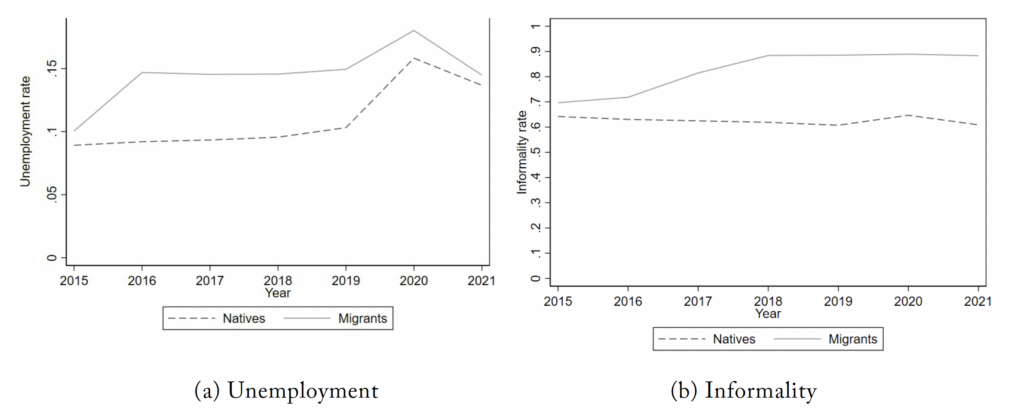
Source: Authors’ calculations using the national household survey (GEIH).
In 2019, around 90 percent of employed Venezuelans worked as “informal” compared to the 60 percent of Colombians. An important fact is that sectors with high informality tend to be the most affected by COVID-19 (Dempster et al. 2020). According to Graham and Guerrero (2020), using data from Colombian household surveys of 2020, it was found that 64 percent of Venezuelan immigrant workers were employed in the sectors that were hit hardest by the pandemic. These sectors included accommodation and food services, manufacturing, real estate, and wholesale and retail trade. In comparison, only 47 percent of Colombians were working in these sectors. Moreover, immigrants made up only 3 percent of the workforce in sectors that were least affected by the pandemic, such as education, human health, social work, public administration, defense, and utilities, compared to the 13 percent of natives who worked in these sectors.
4 Data and Empirical Strategy
4.1 Data
Our analysis hinges on two critical sources of information: The National Household Survey and the Colombian National Census of 2005. The National Household Survey, Gran Encuesta Integrada de Hogares (GEIH), is run by DANE. GEIH is a cross-section monthly survey collecting information in rural and urban areas. This survey provides information about population characteristics, housing characteristics, employment conditions, and immigration. Specifically, we use GEIH from 2016 to 2021, which covers the massive immigration in 2017 as well as the periods before and after the pandemic. Our labor market outcomes of interest are employment, unemployment, labor participation, weekly hours worked, hourly wage, and informality.6We consider wage for salaried workers and labor income for employers and self-employed. Labor participation outcome is a dummy variable that takes the value of one when the respondent is either employed or unemployed. For hourly labor income, we exclude domestic employees, unpaid family workers, and unpaid workers in companies or businesses of other households. Informality is defined following OECD (2019).
Second, we used the national census for 2005 to build an instrumental variable based on past settlements, which helps us predict the current immigration rate. This instrumental variable follows Card (2001) and Caruso, Canon, and Mueller (2019), and uses the proportion of immigrants in a specific department (state) as a predictor of the current geographical distribution of immigrants. Preliminary descriptive analysis, using the last two national censuses (as presented in figure E.1), shows a correlation of 0.87 between the shares of immigrants at the department level between 2005 and 2018. We will discuss the relevance of our instrument in the following section.
We analyze the impact of immigration on labor market outcomes by examining annual cohorts of the GEIH data. Table 1 presents descriptive statistics of our sample. In particular, the table presents labor market outcomes and individual characteristics of natives and immigrants in 2016 (before the largest exodus), 2018 (after the influx shock and before the pandemic), and 2020 (the pandemic period). It reveals the significant increase in immigration influx (i.e., between 2016 and 2020, the stock of working immigrants multiplied by 10). In general, Venezuelan immigrants exhibit worse labor market outcomes than the natives. For instance, immigrants have a higher unemployment rate and informality and lower wages compared to natives, which is consistent with a drop of 43 percent in average labor income (in real terms) during the analysis period. Differences between natives and immigrants are statistically significant, as shown by a mean difference test.
There was a shift in the educational profile of Venezuelan immigrants between 2016 and 2018. The comparison between 2018 and 2020 does not show important differences in immigrant characteristics in terms of age, gender, and education. As expected, in 2020, unemployment grew for immigrants and natives, especially for the latter group. In turn, during 2020, the average labor income decreased by 1.5 percent for natives and 3.4 percent for immigrants. This result suggests that immigrants and natives have different adjustment mechanisms to the labor market due to the pandemic. While for Colombians it presents a sort of quantity effect that is consistent with an increase in the unemployment rate, in the case of immigrants there seems to be a kind of price effect, which is consistent with a higher reduction in labor income.
To complement the analysis of the pandemic, we replicate table 1 but between 2019 and 2021. Table 2 presents relevant information about the adaptation of recent and earlier-term immigrants to the labor market. Recent immigrants present unemployment rates twice as high as locals and earlier-term immigrants in 2019. Differences in labor income are also remarkable. Recent immigrants have a monthly labor income 20 percent lower than earlier-term immigrants and almost 50 percent lower than natives. The arrival of COVID-19 doubled the unemployment rate of the local population. In 2020, the unemployment rate for earlier-term immigrants increased by 16.4 percentage points, almost three times the rate in 2019. For recent immigrants, the rise in unemployment was more attenuated (12.1 percentage points). Notably, there is a significant variation in the employment-intensive margin. The average weekly hours worked were reduced for the two types of immigrants by about five hours, while little variation was observed for native workers. These results are consistent with an important decline in labor income.
In 2021, all three populations experienced a significant decrease in unemployment rates. The pace of recovery was more pronounced for earlier-term immigrants, with a reduction higher than 10 percentage points. This indicates that arrival time might facilitate adaptation to the labor market, but the response to the shock was considerably more volatile. On the other hand, there was also a recovery of the intensive margin of employment for immigrants; in both cases, the average is above 50 hours. Finally, labor income also increased, especially for earlier-term immigrants.
4.2 Identification strategy
To estimate the impact of immigration on labor market outcomes and their differential behavior during lockdown and recovery, we use an instrumental variable identification strategy and an event study specification. Our general estimating equation considers an event study centered on 2019 to facilitate interpretation, as specified in equation 1:
(1)
where stands for individual,
refers for department,
for region, and
represents year.
refers to the labor market outcomes of interest, such as labor status (employment, unemployment, and labor participation) and job quality (hours worked, hourly wage, and informality). The immigration rate
is the share of the working-age immigrants in the department
in period
related to the total stock of the working-age population in the department
. We measure two migration rates, one referring to the total immigration rate and the other to recent immigration.
corresponds to the labor market effects of immigration in 2019. The
captures the impact of the immigration rate of each year with respect to 2019.
is a set of individual characteristics including gender, age, age squared, education, a dummy variable for the head of household, a dummy for rural areas, the dependency ratio of the household, the GDP growth at the department level, and the unemployment rate. The latter two variables allow us to control for pull factors affecting immigration settling decisions. Lastly,
are the year fixed effects, and
are the region fixed effects.
is the error term.
The immigration rate is potentially endogenous because immigrants self-select where to settle according to unobservable factors such as better economic opportunities, networks, violence, or political conditions (see Card 1990; Del Carpio and Wagner 2015; Caruso, Canon, and Mueller 2019; Bohnet, Peralta, and Dos Santos 2021; Di Maio, Sciabolazza, and Molini 2023). To estimate the causal impact of immigration, we build an instrument variable that combines past settlements of immigrants as a source of exogenous variation and the shortest distance to a Venezuelan official entry point.7In Colombia there are eight official Venezuelan entry points. These include Paraguachón (La Guajira - Zulia); Puerto Carreño river port; Inirida fluvial immigration checkpoint; and five international bridges: La Unión (Norte de Santander - Táchira), Francisco de Paula Santander (Norte de Santander - Táchira), Tienditas (Norte de Santander - Táchira), Simón Bolívar (Norte de Santander - Táchira), and José Antonio Páez (Arauca - Apure). We have the coordinates of every crossing point from Migración Colombia. We calculate the distance of the centroid of the department to every crossing point and select the minimum distance (among all the crossing points). This class of instruments is known as shift-share or Bartik instrument (see Bartik 1991). The intuition behind this is that the immigration rate can be instrumented by combining the spatial distribution of a shock (shift), the number of immigrants involved, and an exogenous characteristic (share). In this case, our instrument is defined in equation 2, as follows:
(2)
where refers to the Venezuelan border, and
is the minimum distance between the center of each department and an official entry point (in kilometers).
is the share of Venezuelans in each department in 2005, computed based on the national census.
is the total Venezuelan immigrant stock in Colombia in year
. Therefore,
is the predicted number of immigrants that would arrive in a particular department
in a year
.
Exclusion restriction is based on the “share” term in our setting. Goldsmith-Pinkham, Sorkin, and Smith (2020) argue that the Bartik instruments assume a pooled exposure where the shares have differential exposure to the treatment, and then the exogeneity of the instrument is based on exposure shares that work as the excluded instruments (Borusyak, Hull, and Jaravel 2022). In addition, settlement patterns must be unrelated to other factors determining immigrant settling decisions (i.e., endogeneity might not be solved by the instrument if there are serially correlated labor market demand shocks)(Jaeger, Ruist, and Stuhler 2018; Cho 2019). This issue emerges when unobservable factors might determine the economic conditions and employment of the immigrants (Del Carpio and Wagner 2015; Costas-Fernandez 2018). To control demand shocks and other idiosyncratic factors at the regional level, our specification includes controls related to business cycles and labor demand controls (e.g., GDP and unemployment rate), region, and year-fixed effects.
The relevance of the instrument relies on the fact that immigrants tend to settle in places where other immigrants have previously arrived, which has been discussed in Hoover and Giarratani (1999), DaVanzo (1983), and Rodríguez-Pose and von Berlepsch (2020). Figure E.1 in appendix E compares the distribution of immigrants reported by the national census in 2005 and 2018. Regions close to the border host a high proportion of immigrants, but the four main cities (Bogota, Medellin, Cali, and Barranquilla) are also important. Moreover, the correlation between the percentage of Venezuelan immigrants in 2005 and 2018 is 0.87. This supports the hypothesis that past settlement of immigrants works well as a predictor of immigration flows. To test the relevance of our instrument, table 3 presents the first stage estimates for the level of recent and earlier-term immigration, and table A.1 of appendix A presents the F-test for all endogenous variables.8Additional first stage estimates are available upon request. Estimates show that the instrument is positively associated with both immigration rates, and the correlation is statistically significant (p-value < 0.01) for all years except for the interaction with 2020 (only for recent immigration rate). The high values for the F-test (above 10) suggest the instrument’s relevance.
5 Results
5.1 Impact of immigration on labor market outcomes
We estimate equation 1 to assess the impact of immigration on the labor market outcomes, separating into employment status and job quality outcomes. First, we explore the impact of total migration on natives. Tables B.1 and B.2 of appendix B show the OLS and IV results. OLS results of table B.1 present a non-significant effect of the total migration on the native labor market. However, as we explained, we focus on IV results due to endogeneity concerns. Table B.2 displays evidence that, regarding the labor market status, total migration reduced employment (by 0.51 percentage points) and labor participation (by 0.60 percentage points). On the other side, regarding the labor market quality of natives, results show that total migration increased the hours worked (by 0.46 percentage points) but decreased the hourly wage (by 2.1 percentage points) and increased the informality (by 1.9pa percentage points).
We also study the impact of recent migrants on the labor market of earlier migrants. Tables C.1 and C.2 in appendix C show the OLS and IV results. OLS estimates of table C.1 present a negative impact of recent migration on employment, labor participation, and hourly wages. On the contrary, regarding the labor market status, the IV results of table C.2 are evidence that recent migration had a negative and significant impact only for labor participation of earlier migrants (by 2.9 percentage points). Concerning the labor market quality, recent migration decreased the hourly wage (by 18.17 percentage points) and increased the informality (by 2.48 percentage points) of earlier migrants. These results are consistent with the near-perfect substitutability that exists among the migrants.
Estimates show that the effect of immigration in 2020 significantly worsened the work conditions: fewer working hours for natives (figure 3 and table B.2) but more working hours and lower hourly wages for migrants (figure 4 and table C.2). Total migration reduced the hours worked by natives by 0.35 percentage points in 2020 compared to 2019. On the other side, recent migration has not affected labor participation, but it has impacted employment. Specifically, in 2020 compared to 2019, recent migration increased the employment of earlier migrants (by 2.45 percentage points), but this came at the cost of an increase in hours worked (by 6.2 percentage points) at lower hourly wages (by 9.9 percentage points). The fact that migration had a greater effect on earlier migrants than natives during the pandemic reveals the vulnerability of the first population even when they had experienced labor market assimilation and had time to build a network before the pandemic.
The reduction of wages among natives is consistent with the findings of Caruso, Canon, and Mueller (2019), Santamaria (2022), and Delgado-Prieto (2020), which evidenced that Venezuelan migration reduces wages; but wages are conditional to the formality of the sector—informal sectors are more likely to adjust natives wages due to the flexibility of migrants’ reservation wage. The latter also is consistent with the higher informality of natives, given the displacement effect on native employment in the formal sector, as Delgado-Prieto (2020) explains.
Comparing those effects, we demonstrate that the arrival of new migrants has greater effects on labor participation, hourly wage, and informality of earlier migrants compared to the effect that total migration has on the same outcomes for natives. This confirms the imperfect substitutability among migrants and natives and the almost-perfect substitutability among migrants. Likewise, the fact that recent migration affects earlier migrants in a greater magnitude suggests that migrants are the most vulnerable population during a crisis, even with the arrival of peers. Networks, labor market assimilation, and informality levels can explain why earlier migrants were more affected than natives by the pandemic.
Regarding the recovery period, the effect of total migration in 2021 had the opposite sign of the pandemic year 2020. For instance, in 2021, compared to 2019, total migration increased employment and labor participation by around 0.2 percentage points. It decreased the hours worked by 0.38 percentage points but increased the hourly wage by 0.57 percentage points. The informality also decreased by 0.23 percentage points in 2021 compared to 2019. The latter suggests the rapid labor market recovery experienced by natives. A similar scenario is presented for the impact of recent migration on the labor market outcomes of earlier migrants; for example, in 2021, employment increased by 4.95 percentage points, and labor participation increased by 3.4 percentage points compared to 2019. Once again, the effects on earlier migrants were greater (around double) than those on natives. We do not find significant effects on any other outcome in this recovery year.
Figure 3: Impact of total migration on labor market outcomes of native
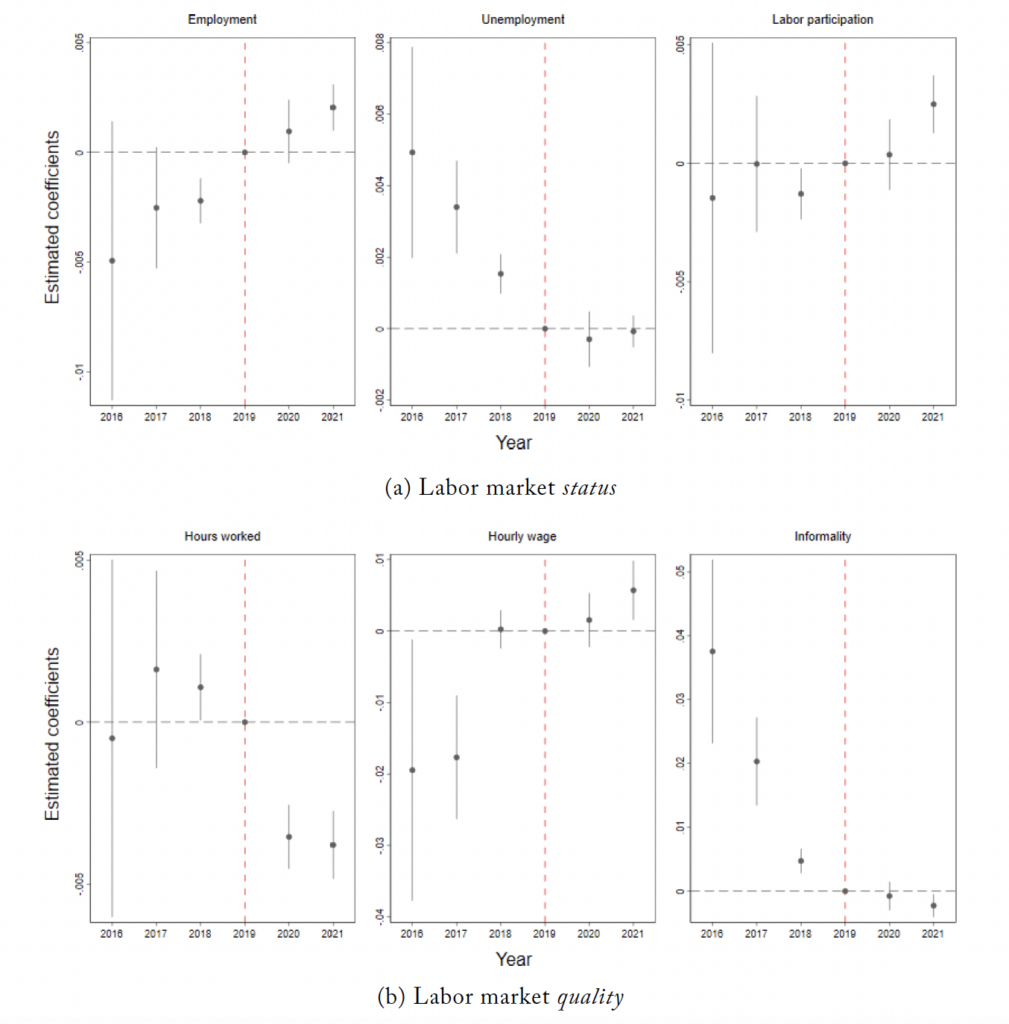
Notes: Calculations are based on working age-population. The set of covariates described in equation 1 are the plotted coefficients. Standard errors are clustered at the department level.
Source: Authors’ calculations using the national household survey (GEIH).
Figure 4: Impact of recent migration on labor market outcomes of earlier migrants
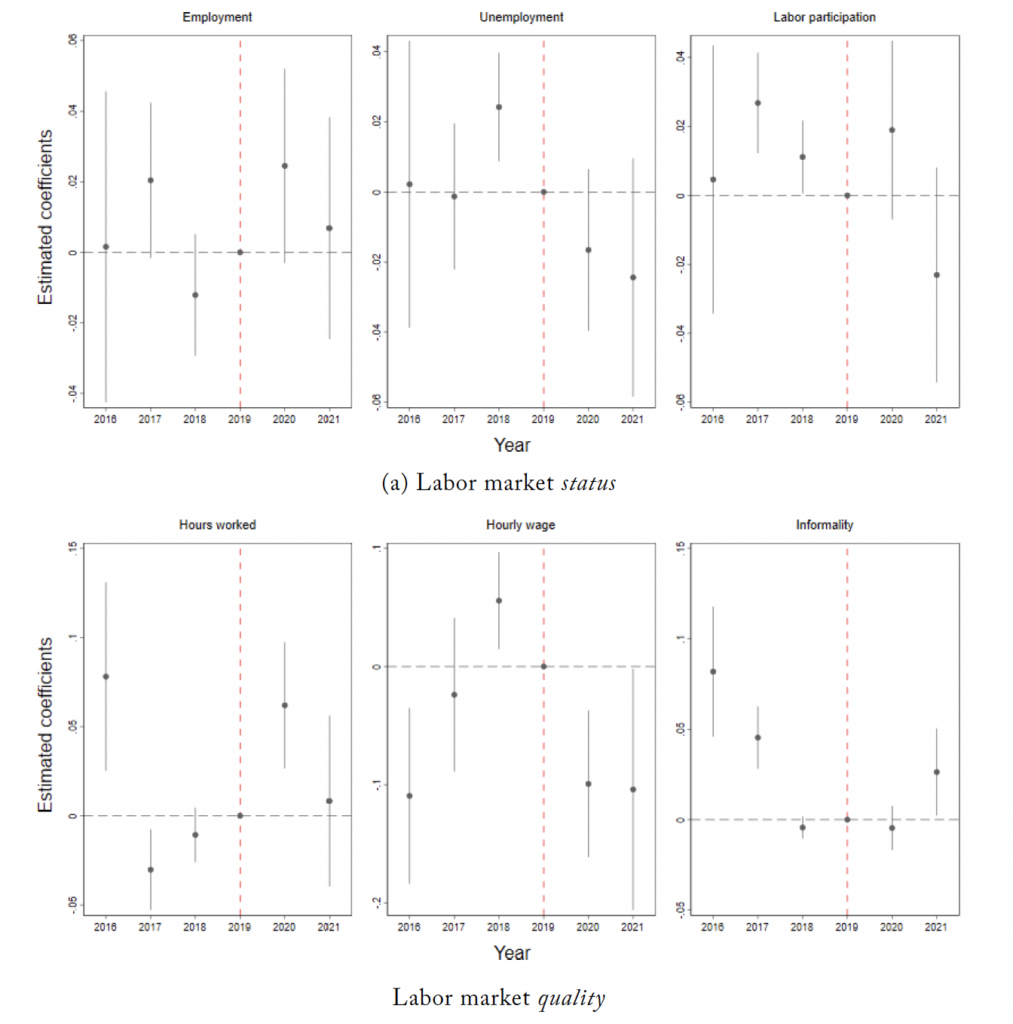
Notes: Calculations are based on the working-age population. The set of covariates described in equation 1 are the plotted coefficients. Standard errors are clustered at the department level.
Source: Authors’ calculations using the national household survey (GEIH).
5.2 Heterogeneous effects
We examine how immigration affects the labor market for native workers, considering individual characteristics such as gender, education level, age group, and informality status. Tables D.1, D.2, D.3, and D.4 in appendix D present the heterogeneous effects respectively. Figures D.1, D.2, D.3, and D.4 in appendix D show the corresponding point estimators. Our results indicate that the natives most impacted by total migration include women, informal workers, the youngest, and the least educated.
Heterogeneous analysis reveals interesting patterns across our groups of analysis. Regarding the gender comparison, we find that female natives are the most affected by labor market status, but native men are the most harmed in job quality (see table D.1). For example, total migration impacts in a higher magnitude (doubles and more) the employment and labor participation of native women compared to native men. Specifically, total migration reduced employment by 0.35 percentage points for native men, but by 0.75 percentage points for native women. Likewise, total migration decreased labor participation by 0.27 percentage points for native men, but by 0.93 percentage points for native women (more than three times). Total migration also negatively affected the hourly wages of both women and men but increased the informality rates; however, for this particular outcome, the higher impact is led by native men.
On the other hand, we found that the youngest native population is the most affected by total migration for both labor market status and quality (see table D.2). For example, total migration reduced the unemployment rate of those natives above 33 years old by 0.24 percentage points and reduced it for the natives below 33 years old by 0.83 percentage points. Similar trends occur for the reduction in labor participation and hourly wages and for the increase in hours worked and informality. Total migration increased the unemployment rate by 0.24 percentage points for the youngest population but did not significantly affect the native population above 33 years old. Considering that the migrant population is predominantly young, it makes sense that the youngest natives are the most affected.
The impact of immigration on the native workforce also significantly varies across education levels (see table D.3). For instance, low-educated natives are the most harmed regarding labor market status but are less impacted regarding job quality. Total migration decreased the employment rate of low-educated natives by 0.43 percentage points and did it for the high-educated natives by 0.69 percentage points. In the same way, total migration decreased the labor participation of low-educated natives by 0.5 percentage points and did it for high-educated natives by 0.76 percentage points. The opposite happens with job quality outcomes. The magnitude of the decrease in hourly wages and the increase in informality is higher for low-educated natives. Total migration did not significantly affect unemployment for either group.
In 2020, marginal effects on labor quality included increased informality and reduced hours worked, especially for highly educated natives, compared to 2019. Post-pandemic, there is a modest improvement for the less educated, marked by a 0.19 percentage point increase in employment and a 0.35 percentage point reduction in informality relative to 2019. In contrast, highly educated natives experienced an uptick in employment (0.26 percentage point increase compared to 2019) but slightly reduced hours worked (0.13 percentage point reduction compared to 2019). Finally, regarding the formality status (see table D.4), in general terms, immigration primarily affected informal workers, leading to a notable 2.0 percentage point decrease in hourly wages and a 1.29 percentage point increase in working hours for native workers. However, it is worth noting that these effects reversed over time. Interestingly, in the pandemic year 2020, total migration significantly decreased the hours worked by informal workers (by 0.48 percentage points compared to 2019) compared to the reduction in formal workers (0.15 percentage points compared to 2019). This underscores the presence of a price effect—the observed adjustments were exclusively related to income and linked to the informality status of the workers. However, during the recovery year 2021, informal native workers experienced higher (lower) hours worked (hourly wage), reflecting how the vulnerability of their informal status affected their recovery after the COVID-19 crisis.
6 Concluding Remarks
Migration from Venezuela to Colombia is one of the largest migratory phenomena in recent decades, and its impact on the labor market is particularly relevant in the context of the pandemic in which immigrants are more vulnerable and, therefore, can generate greater distortions in the labor market. This article investigates the causal effect of migration on natives and earlier migrants during and after the COVID-19 pandemic, specifically on their labor market outcomes related to status and quality. We use an event study framework combined with instrumental variables to examine the change of the impact over time, and we acknowledged endogeneity concerns. Our results indicate that recent migration has greater negative effects on earlier migrants, compared to the impact that total migration has on natives. This is consistent with the expected higher degree of substitutability among migrants compared to migrants and natives. We also have evidence that during COVID-19 those negative effects remained the same, and that after the COVID-19 pandemic natives experienced a better recovery than earlier migrants, which confirms the vulnerability of migrants during the crisis even when they had already lived for a time in the host country and even with the arrival of peers.
General results indicate that overall migration led to an increase in informality among natives and a decrease in their employment rate, labor participation, and hourly wages. Concerning migrants, we evaluate how the arrival of new migrants impacted the labor market outcomes of earlier migrants. We see an increase in informality and a decrease in their labor participation and hourly wage. Estimates show that the effect of immigration in 2020 significantly worsened the work conditions (i.e., fewer working hours for natives but more working hours and lower hourly wages for migrants). Likewise, we show how the impact of migration during the recovery period (2021) changed the sign of the effects only for natives, though it did at least reduce the magnitude for earlier migrants. Additionally, we examined the heterogeneous effects of the impact of migration by gender, age, education level, and formality status, and have evidence that women, the youngest, the less educated, and the informal native workers are the most impacted by total migration. Policymakers should consider the heterogeneous effects on different population groups when designing migration and labor market policies. This is an interesting result from a public policy perspective since immigrants from Venezuela constitute a demographic bonus that will have growth and productivity effects in the long run. While current efforts, such as introducing labor market permits for Venezuelans, are a notable advancement, public policies for this population must persist in fostering the long-term productivity benefits associated with immigration.
Appendix A. First Stage
Appendix B. Impact of Total Migration on Natives
Appendix C. Impact of Recent Migration on Earlier Migrants
Appendix D. Heterogeneous Effects
Figure D.1: Impact of total migration on natives, by gender
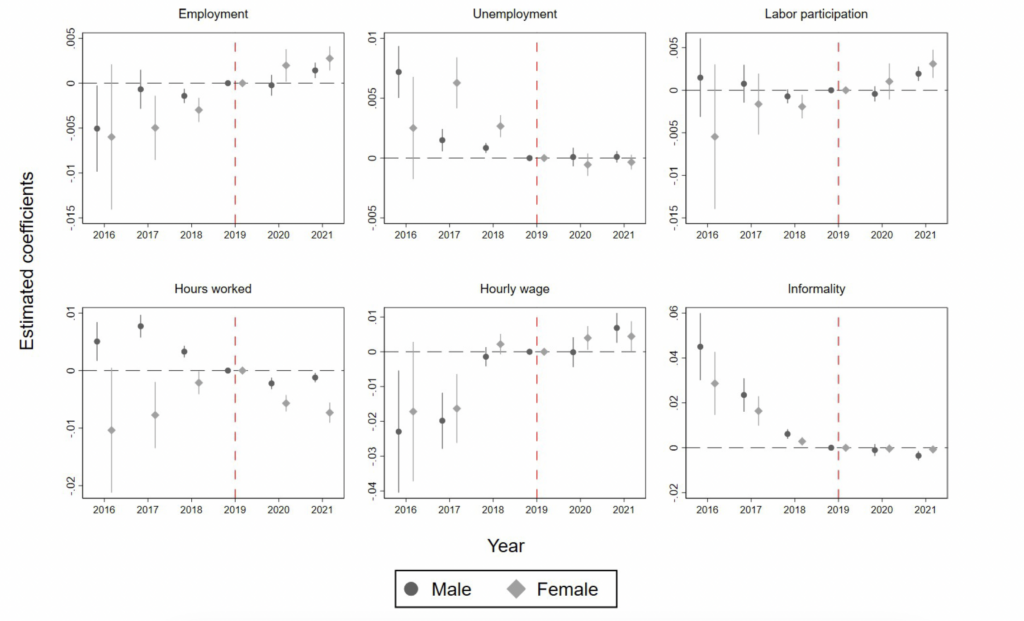
Notes: Calculations are based on the working-age population. The set of covariates described in equation 1 are the plotted coefficients. Standard errors are clustered at the department level.
Source: Authors’ calculations using the national household survey (GEIH).
Figure D.2: Impact of total migration on natives, by age group
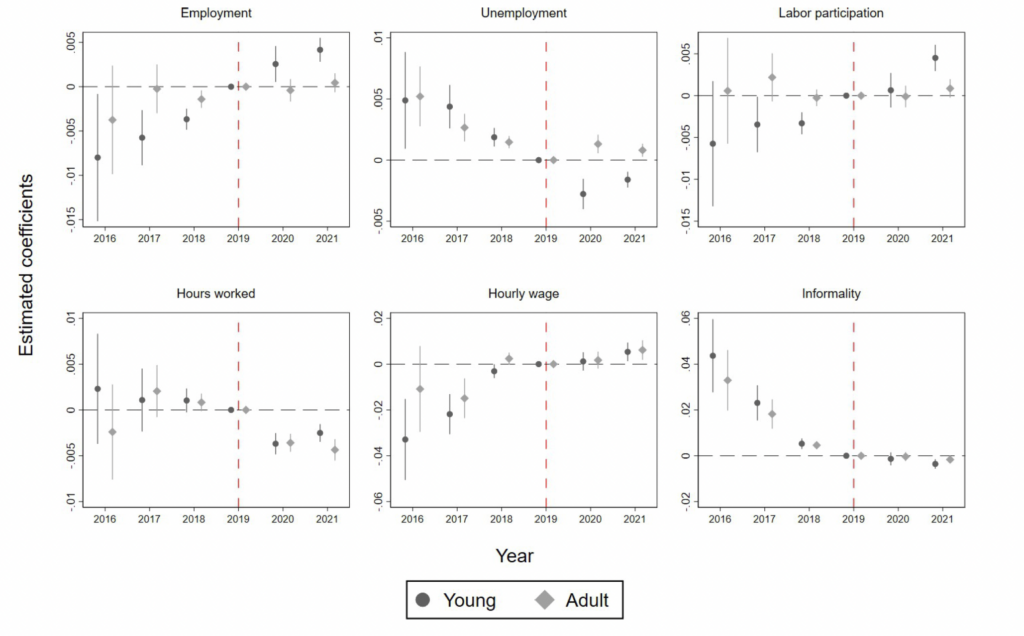
Notes: Adults are individuals aged 33 years or older, and young respondents are younger than 33. Calculations are based on the working-age population. The set of covariates described in equation 1 are the plotted coefficients. Standard errors are clustered at the department level.
Source: Authors’ calculations using the national household survey (GEIH).
Figure D.3: Impact of total migration on natives, by education level
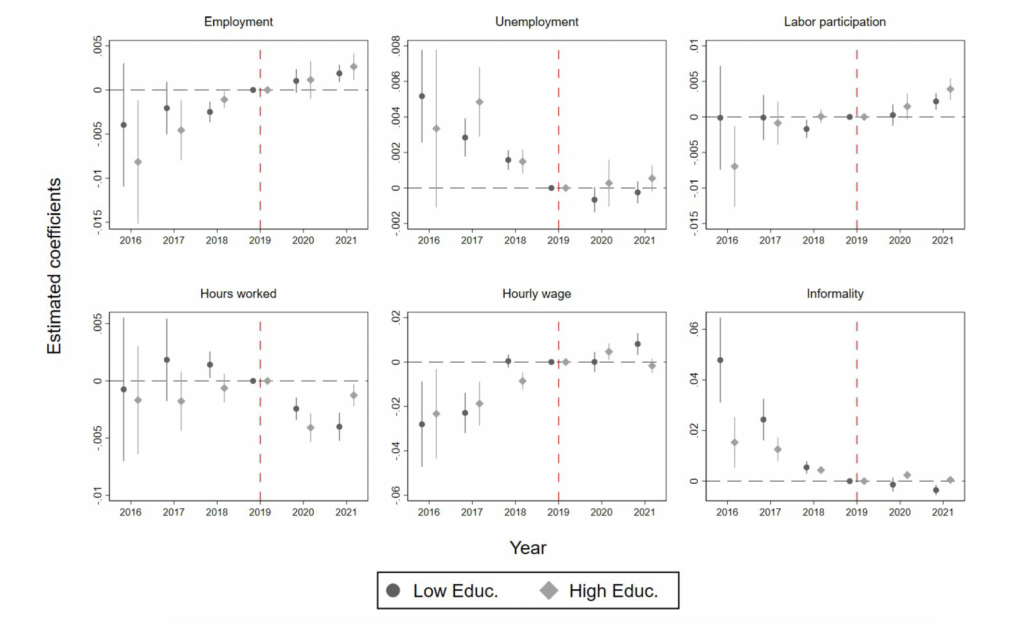
Notes: High-education respondents have over 12 years of education. Low-education respondents are individuals with 12 or fewer years of education. Calculations are based on the working-age population. The set of covariates described in equation 1 are the plotted coefficients. Standard errors are clustered at the department level.
Source: Authors’ calculations using the national household survey (GEIH).
Figure D.4: Impact of total migration on natives, by informality status
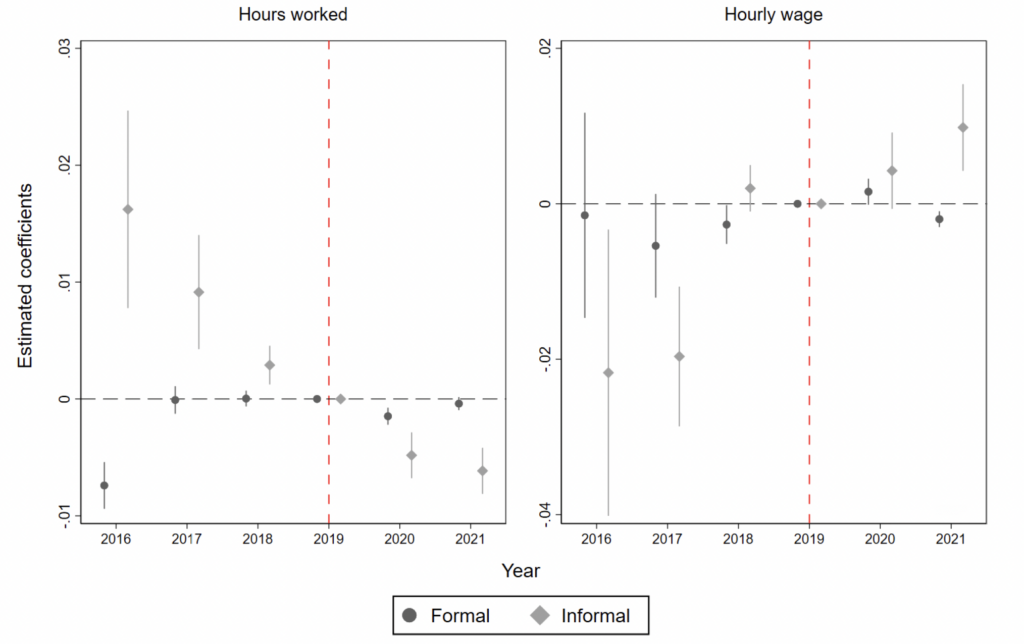
Notes: Informality outcome is not calculated due to collinearity. Informality is defined following OECD (2019). Calculations are based on the working-age population. The set of covariates described in equation 1 are the plotted coefficients. Standard errors are clustered at the department level.
Source: Authors’ calculations using the national household survey (GEIH).
Appendix E. Geographical Distribution of Venezuelans in Colombia
Figure E.1: Percentage of Venezuelan immigrants in Colombia, 2005 and 2018
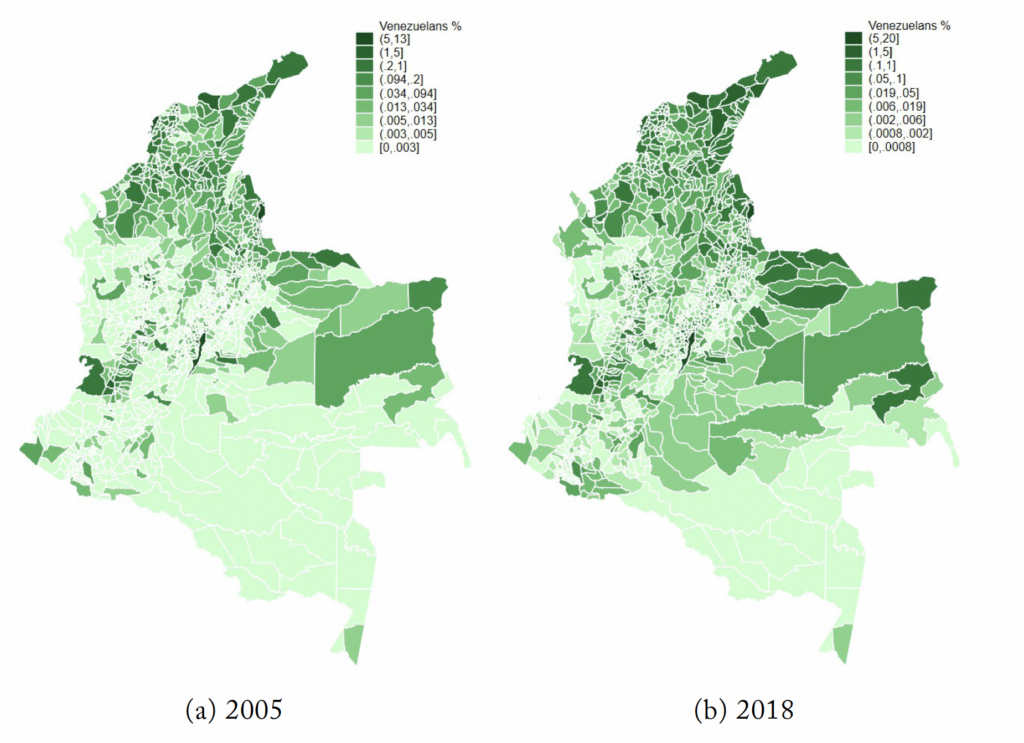
Source: Authors’ calculations using the national census of 2005 and 2018.
References
Aksu, E., Erzan, R., & Kırdar, M. G. (2022). The impact of mass migration of Syrians on the Turkish labor market. Labour Economics, 76, Article 102183.
Alhadeff, S. (2021). Venezuelan emigration, explained [Report]. Woodrow Wilson International Center for Scholars.
Atkeson, A. (2020). What will be the economic impact of COVID-19 in the US? Rough estimates of disease scenarios [Working paper]. National Bureau of Economic Research.
Bartik, T. J. (1991). Who benefits from state and local economic development policies? W. E. Upjohn Institute.
Béland, L.-P., Brodeur, A., & Wright, T. (2023). The short-term economic consequences of COVID-19: Exposure to disease, remote work, and government response. PLOS ONE, 18(3), Article 0270341.
Ben Atta, O., Chort, I., & Senne, J.-N. (2022). Immigration, integration, and the informal economy in OECD countries (GLO Discussion Paper Series 1197). Global Labor Organization.
Bohnet, L., Peralta, S., & Dos Santos, J. P. (2021). Cousins from overseas: The labour market impact of half a million Portuguese repatriates [Working paper no. 2114]. NOVAFRICA.
Bonilla-Mejía, L., Morales, L. F., Hermida-Giraldo, D., Flórez, L. A. (2020). El mercado laboral de los inmigrantes y no inmigrantes: Evidencia de la crisis Venezolana de refugiados [Technical report]. Banco de la República de Colombia.
Borjas, G. J., & Monras, J. (2017). The labour market consequences of refugee supply shocks. Economic Policy, 32(91), 361–413.
Boruchowicz, C., Martinelli, C., & Parker, S. W. (2021). Economic consequences of mass migration: The Venezuelan exodus in Peru.
Borusyak, K., Hull, P., & Jaravel, X. (2022). Quasi-experimental shift-share research designs. Review of Economic Studies, 89(1), 181–213.
Card, D. (1990). The impact of the Mariel boatlift on the Miami labor market. ILR Review, 43(2), 245–257.
Card, D. (2001). Immigrant inflows, native outflows, and the local labor market impacts of higher immigration. Journal of Labor Economics, 19(1), 22–64.
Cárdenas, M., & Beltrán, H. M. (2020). COVID-19 in Colombia: Impact and policy responses. Center for Global Development.
Caruso, G., Canon, C. G., & Mueller, V. (2019). Spillover effects of the Venezuelan crisis: Migration impacts in Colombia. Oxford Economic Papers.
Ceritoglu, E., Yunculer, H. B. G., Torun, H., & Tumen, S. (2017). The impact of Syrian refugees on natives’ labor market outcomes in Turkey: Evidence from a quasi-experimental design. IZA Journal of Labor Policy, 6(1), 1–28.
Cho, H. (2019). Instrumenting for immigration using push factors of origin countries [Working paper].
Coccia, M. (2020). Two mechanisms for accelerated diffusion of COVID-19 outbreaks in regions with high intensity of population and polluting industrialization: The air pollution-to-human and human-to-human transmission dynamics [Preprint]. MedRxiv.
Costas-Fernandez, J. (2018). Examining the link between migration and productivity [Working paper]. Migration Advisory Committee.
DANE. (2019). Publicación del módulo de migración: Resultados y análisis del módulo [Household survey]. https://www.dane.gov.co/files/investigaciones/boletines/ech/ml-migracion/presentacion-geih-migracion-2012-2019.pdf.
DaVanzo, J. (1983). Repeat migration in the United States: Who moves back and who moves on? Review of Economics and Statistics, 65(4), 552–559.
Del Carpio, X. V., & Wagner, M. C. (2015). The impact of Syrian refugees on the Turkish labor market [Policy research working paper no. 7402]. World Bank.
Delgado-Prieto, L. (2020). Dynamics of local wages and employment: Evidence from the Venezuelan immigration in Colombia [Unpublished].
Dempster, H., Ginn, T., Graham, J., Guerrero Ble, M., Jayasinghe, D., Shorey, B. (2020). Center for Global Development, Refugees International, and International Rescue Committee.
Di Maio, M., Sciabolazza, V. L., & Molini, V. (2023). Migration in Libya: A spatial network analysis. World Development, 163, 106–139.
Dustmann, C., Glitz, A., & Vogel, T. (2010). Employment, wages, and the economic cycle: Differences between immigrants and natives. European Economic Review, 54(1), 1–17.
El País (2020, July 6). Migración Colombia se alista para regreso de venezolanos tras pandemia.
Goldsmith-Pinkham, P., Sorkin, I., & Swift, H. (2020). Bartik instruments: What, when, why, and how. American Economic Review, 110(8), 2586–2684.
Graham, J., & Guerrero, M. (2020). The effect of COVID-19 on the economic inclusion of Venezuelans in Colombia [Technical report]. Center for Global Development.
Gunadi, C. (2021). The labour market effects of Venezuelan refugee crisis in the United States. Oxford Bulletin of Economics and Statistics, 83(6), 1311–1340.
Hoover, E., & Giarratani, F. (1999). An introduction to regional economics. West Virginia University Regional Research Institute.
IADB & OECD. (2021). Migration flows in Latin America and the Caribbean: Statistics on permits for migrants. Inter-American Development Bank.
ILO. (2020). Impact of COVID-19 on Syrian refugees and host communities in Jordan and Lebanon [Policy brief]. International Labour Organization.
IOM. (2020). Migration factsheet no. 6 – The impact of COVID-19 on migrants [Technical report]. International Organization for Migration.
Jaeger, D. A., Ruist, J., & Stuhler, J. (2018). Shift-share instruments and dynamic adjustments: The case of immigration [Working paper no. 24285]. National Bureau of Economic Research.
Jordá, O., Singh, S. R., & Taylor, A. M. (2020). Longer-run economic consequences of pandemics. Review of Economics and Statistics, 104(1), 166–175.
Lebow, J. (2023). Immigration and occupational downgrading in Colombia. Journal of Development Economics, 166, Article 103164.
Lombardo, C., Martínez Correa, J., Peñaloza Pacheco, L. J., & Gasparini, L. C. (2021). The distributional effect of a massive exodus in Latin America and the role of downgrading and regularization. Documentos de Trabajo del CEDLAS.
Lombardo, C., & Peñaloza Pacheco, L. J. (2021). Exports “brother-boost”: The trade-creation and skill-upgrading effect of Venezuelan forced migration on Colombian manufacturing firms. Documentos de Trabajo del CEDLAS.
Malagón-Rojas, J., Ibáñez, E., Parra Barrera, E. L., Toloza-Perez, Y. G., Álvarez, S., & Mercado, M. (2021). Analysis of COVID-19 mortality and survival in Colombia: A prospective cohort study. Infectio, 25(3), 176–181.
Martínez Moya, D. A. (2020). The effect of a labor supply shock on factors productivity: The case of a Venezuelan migration in Colombia [Doctoral dissertation, Universidad Eafit]. DSpace.
Migración Colombia. (2020). Para finales del 3 de mayo, el 3% del total de Venezolanos que se encontraba en Colombia al comienzo de la pandemia habría regresado a su país. Available on: https://bit.ly/3LsNhSJ.
Morando, G. (2021). The early effect of the COVID-19 pandemic on the labour market outcomes of natives and migrants in the UK [Discussion paper no. 14699]. Institute of Labor Economics.
Muñoz-Mora, J. C., Aparicio, S., Martinez-Moya, D., & Urbano, D. (2022). From immigrants to local entrepreneurs: Understanding the effects of migration on entrepreneurship in a highly informal country. International Journal of Entrepreneurial Behavior and Research, 28(9), 78–103.
National Planning Department. (2022). Informe Nacional de caracterización de población migrante de Venezuela [Technical report].
OECD. (2018). Balance preliminar de las economías de América Latina y el Caribe [Technical report].
OECD. (2019). Tackling vulnerability in the informal economy. Organisation for Economic Co-operation and Development.
OECD. (2022). Tackling informality in Colombia with the social and solidarity economy [LEED Program paper].
Olivieri, S., Ortega, F., Rivadeneira, A., & Carranza, E. (2022). The labour market effects of Venezuelan migration in Ecuador. Journal of Development Studies, 58(4), 713–729.
Orrenius, P. M., & Zavodny, M. (2010). Mexican immigrant employment outcomes over the business cycle. American Economic Review, 100(2), 316–320.
Ottaviano, G. I., & Peri, G. (2012). Rethinking the effect of immigration on wages. Journal of the European Economic Association, 10(1), 152–197.
Pedrazzi, J., & Peñaloza-Pacheco, L. (2023). Heterogeneous effects of forced migration on the female labor market: The Venezuelan exodus in Colombia. Journal of Development Studies, 59(3), 324–341.
Peguero, A. A. (2006). Latino disaster vulnerability: The dissemination of hurricane mitigation information among Florida’s homeowners. Hispanic Journal of Behavioral Sciences, 28(1), 5–22.
Ramelli, S., & Wagner, A. F. (2020). Feverish stock price reactions to COVID-19. Review of Corporate Finance Studies, 9(3), 622–655.
Ramoni Perazzi, J., Orlandoni Merli, G., Torres Rivas, E., & Zambrano, A. (2017). Analysis of the duration of unemployment and outcomes for unemployed persons in the Bolivarian Republic of Venezuela. CEPAL Review.
Rodríguez-Pose, A., & von Berlepsch, V. (2020). Migration-prone and migration-averse places: Path dependence in long-term migration to the US. Applied Geography, 116, 102–157.
Roselli, D. (2020). Epidemiología de las pandemias. Medicina, 42(2), 168–174.
Ruiz, I., & Vargas-Silva, C. (2013). The economics of forced migration. Journal of Development Studies, 49(6), 772–784.
Ryu, H., & Paudel, J. (2022). Refugee inflow and labor market outcomes in Brazil: Evidence from the Venezuelan exodus. Population and Development Review, 48(1), 75–96.
Santamaria, J. (2022). When a stranger shall sojourn with thee’: The impact of the Venezuelan Exodus on Colombian Labor Markets [Working paper]. EFI Alliance.
Shamsuddin, M., Acosta, P. A., Battaglin Schwengber, R., Fix, J., & Pirani, N. (2021). Economic and fiscal impacts of Venezuelan refugees and migrants in Brazil [Policy research working paper no. 9797]. World Bank.
Sinha, S., Narain, N., & Bhanjdeo, A. (2022). Building back better? Resilience as wellbeing for rural migrant households in Bihar, India. World Development, 159(4), Article 106031.
Tumen, S. (2016). The economic impact of Syrian refugees on host countries: Quasi-experimental evidence from Turkey. American Economic Review, 106(5), 456–60.
Vera, C. P., & Jiménez, B. (2022). The short-term labor market impact of Venezuelan Immigration in Peru. Documentos de Trabajo del CEDLAS.
Verme, P., & Schuettler, K. (2021). The impact of forced displacement on host communities: A review of the empirical literature in economics. Journal of Development Economics, 150, Article 102606.
Wolfe, G. (2021). Where are Venezuelan migrants and refugees going? An analysis of legal and social contexts in receiving countries [Report]. Center for Migration Studies of New York.
World Health Organization. (2020). WHO coronavirus disease dashboard.






